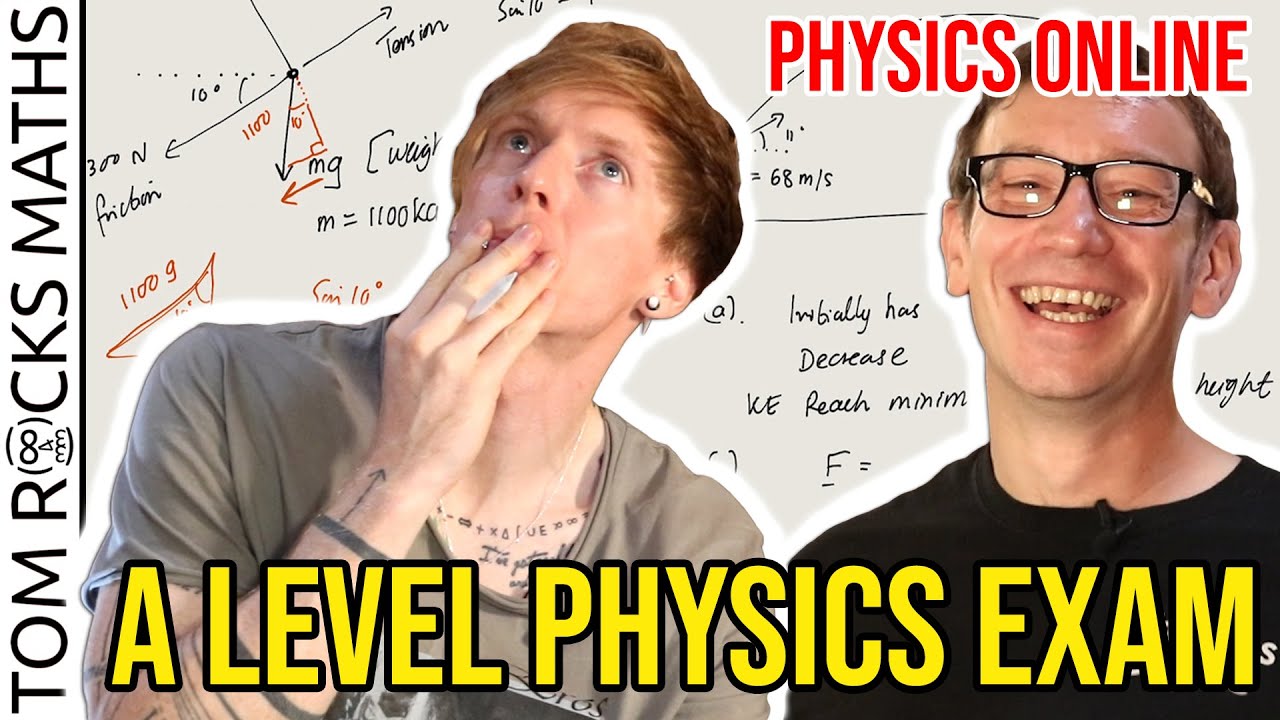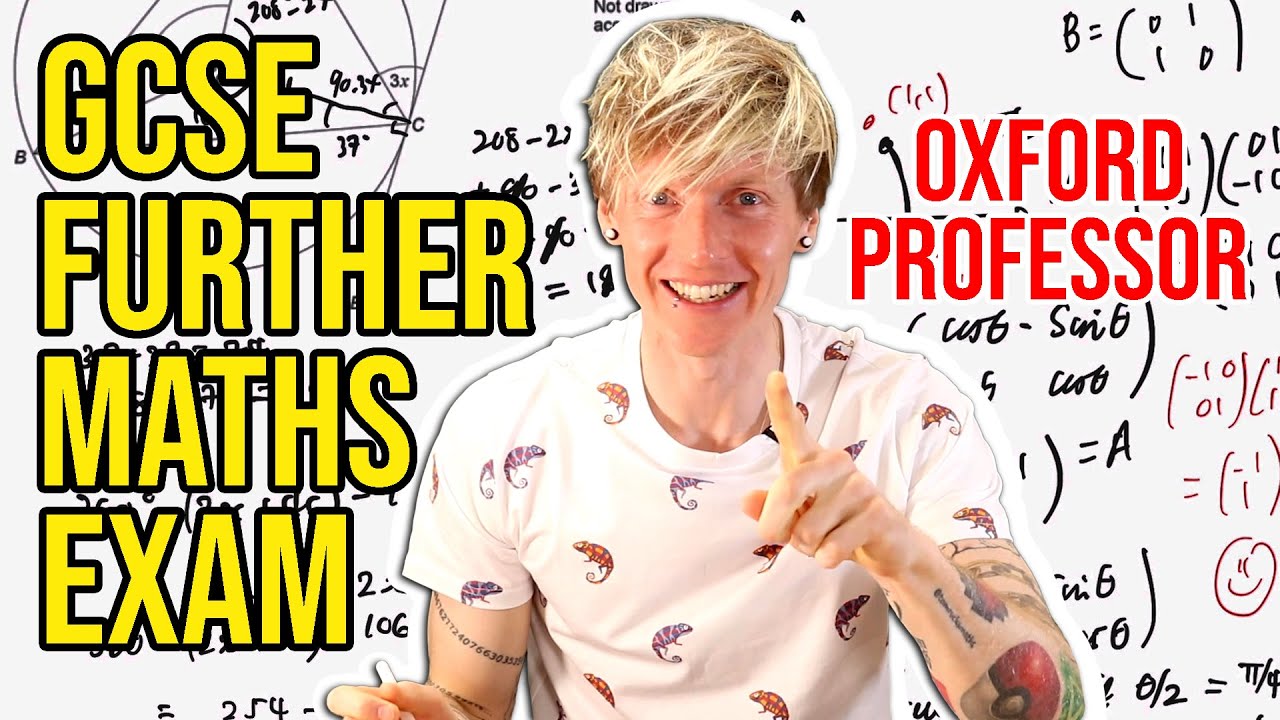George And James Take GCSE Maths Exam
TLDRIn this entertaining and educational video, the host is joined by James as they tackle a GCSE Foundation Tier maths paper, aiming to demonstrate that it's not as challenging as it seems. Throughout the video, they humorously work through various maths problems, including bar charts, angles, and probability, with the host occasionally expressing surprise at the simplicity of the questions. They also discuss the nature of the exam, which seems designed for students aiming for a pass grade. The duo's banter and light-hearted approach to the subject matter make the video not only informative but also engaging, as they share their thoughts on the types of questions and the logic behind solving them. The video concludes with a teaser for a potential follow-up video on GCSE science, suggesting a series of educational content that combines humor with learning.
Takeaways
- 📚 The video features a discussion about tackling a GCSE Foundation Tier maths paper, indicating the paper's difficulty level is aimed at students who are aiming for a grade C or below.
- 🐎 George confidently claims that the maths paper is simple, reflecting his belief that he could easily achieve a passing grade despite not having done maths for several years.
- 🤔 James and George engage in a humorous debate over the number of sheep on a farm, based on a bar chart, showcasing their approach to problem-solving and estimation.
- 📏 George struggles with measuring angles and lengths without tools, highlighting the practical challenges faced when attempting mathematical problems without the necessary equipment.
- 🔢 The transcript includes a mix of basic arithmetic, geometry, and probability questions, demonstrating the variety of topics covered in the GCSE maths paper.
- 🏷️ James and George discuss the concept of 'acute angles' and other mathematical terms, showing their process of recalling and applying mathematical knowledge.
- 📉 A stem and leaf diagram is mentioned, but George expresses his unfamiliarity with the concept, indicating the range of mathematical skills and knowledge that might be tested.
- 💵 The paper includes a word problem about calculating the cost of cereal, which James refers to as a reading comprehension task, emphasizing the importance of understanding the question before attempting to solve it.
- 🧮 Towards the end, the pair attempt more complex problems involving factorization and algebra, which they find challenging, reflecting the increased difficulty towards the latter part of the paper.
- ⏱️ Time management is briefly touched upon when discussing the duration of a film at the cinema, indicating the real-world application of mathematical skills.
- 🤓 The video concludes with the hosts contemplating taking on more challenging subjects, such as science, for future videos, suggesting their willingness to expand their educational content.
Q & A
What is the context of the video described in the transcript?
-The video is about two individuals, presumably named James and George, who are attempting to solve a GCSE Foundation Tier maths paper. The transcript captures their dialogue and interactions as they work through the problems.
Why does James mention that the maths paper is simple?
-James mentions that the maths paper is simple because he had previously taken the exam when he was younger and believes that the questions are not as challenging as he remembered.
What does George incorrectly assume about the number of sheep on the farm based on the bar chart?
-George incorrectly assumes that there are 12 sheep on the farm, as he rounds the number up to the closest whole number. However, the correct approach would be to consider the number as halfway between 12 and 10, which would be 11.
What is the humorous mistake made by George when trying to measure an angle on the screen?
-George humorously attempts to use a physical tape measure to measure an angle on the screen, not realizing that this method is not applicable to digital content.
What is the nature of the maths problems they are solving?
-The maths problems they are solving are from a GCSE Foundation Tier paper, which is designed for students aiming for a grade C or below. The problems include bar chart interpretation, basic arithmetic, geometry, and probability, among others.
Why does James question the difficulty of the paper?
-James questions the difficulty of the paper because he and George are able to solve the problems relatively easily, leading him to believe that the paper is not as challenging as it was when he took it.
What is the confusion regarding the units of measurement for the area of the shaded rectangle?
-There is a confusion between James and George about whether the area should be measured in centimeters or centimeters squared. The correct unit for area is square units, so it should be centimeters squared.
What is the humorous interaction regarding the cereal question in the paper?
-The humorous interaction occurs when George and James are trying to identify the name of the cereal based on its weight in grams. They humorously guess 'Cornflakes' and 'Rice Krispies' before realizing they need to focus on the weight to find the correct answer.
Why does George feel confident about solving the probability question?
-George feels confident about solving the probability question because he understands that it involves calculating the likelihood of an event occurring, which in this case is drawing a card with a square shape from a set of cards with different shapes.
What is the mistake made by George when calculating the number of sticks in pattern number twelve?
-George initially makes a mistake by stating that there are six sticks in pattern number twelve, but then corrects himself to 25, which is the correct count based on the pattern described.
What is the final decision made by James and George regarding their future content?
-The final decision made by James and George is to continue with their educational content, suggesting that they might do a GCSE Science paper next, after receiving positive feedback from their viewers.
Outlines
📚 GCSE Maths Paper Challenge
The video opens with the host and James discussing the GCSE foundation tier maths paper they are about to tackle. The host humorously admits to being bad at maths and expresses surprise at the simplicity of the paper, which is designed for students aiming for a C grade or below. They proceed to answer questions on the paper, which include interpreting bar charts, calculating areas and perimeters, and dealing with numerical sequences, showcasing their problem-solving process and occasional confusion.
🧮 Maths Problem-Solving and Misunderstandings
In this segment, the host and James continue to work through the maths paper, encountering questions on probability, geometry, and data interpretation. They demonstrate different methods for solving problems, occasionally disagreeing on approaches and outcomes. The dialogue is filled with humor and light-hearted banter, making the process of solving maths problems more engaging and entertaining.
🤔 Confusion and Clarity in Mathematical Reasoning
The conversation in this part revolves around more complex mathematical concepts such as tessellation, ratios, and volume calculation. The host and James struggle with some questions, showing their thought process and the steps they take to reach a solution. There's a mix of correct and incorrect attempts, with James often providing corrections or clarifications, leading to a better understanding of the subject matter.
🎬 Wrapping Up the GCSE Maths Paper
As the video nears its end, the host and James complete the last few questions on the maths paper, which include factorization and more complex algebra. They reflect on the difficulty of the paper and contemplate taking on more challenging subjects in future videos. The host expresses a desire to move on to a GCSE science paper, and they encourage viewers to like, comment, and subscribe for more educational content.
Mindmap
Keywords
💡GCSE
💡Maths Paper
💡Bar Chart
💡Acute Angle
💡Combination
💡Perimeter
💡Probability
💡Mode
💡Range
💡Factorize
💡Tessellation
Highlights
James and the host discuss the simplicity of a GCSE Foundation Tier maths paper, which is designed for students aiming for a grade C or below.
The host confidently claims to have passed the paper easily, having taken it in their first year of high school.
A humorous debate about the number of horses on a farm based on a bar chart, with James and the host disagreeing on whether to round up or down.
The host incorrectly assumes the value of an angle in a diagram, later corrected by James to 37 degrees.
James and the host struggle with a question about ordering food and drinks at a cafe, highlighting the complexity of seemingly simple problems.
The host incorrectly calculates the number of sticks in a pattern, showcasing a moment of confusion in their mathematical process.
James and the host have a light-hearted argument about the cost of a box of Frosties, blending maths with reading comprehension.
The host demonstrates a lack of understanding of the term 'acute angle', leading to a brief educational moment with James.
James and the host successfully navigate a question about the probability of drawing a card with a square shape from a deck.
The host incorrectly identifies a quadrilateral as a kite, leading to a discussion about the properties of different quadrilaterals.
James and the host attempt to calculate the time a film finishes at the cinema, with a humorous side note about including advertisements.
The host mistakenly believes that the number of boys and girls in a cinema audience can be calculated without considering adults, leading to a correction by James.
James and the host engage in a playful discussion about the distance Nigel travels and the time he spends at a friend's house, integrating basic arithmetic with a storytelling element.
The host humorously admits to not understanding a question about fractions, leading to a brief explanation by James.
James and the host tackle a complex maths problem involving the weights of eggs, demonstrating a mix of confusion and determination.
The host incorrectly attempts to factorize an expression, leading to a moment of clarity as James steps in to correct the process.
The video concludes with the host and James contemplating tackling a GCSE Science paper next, hinting at future content.
Transcripts
Browse More Related Video

Can an Oxford University Mathematician solve a High School Physics Exam? (with @PhysicsOnline)

Oxford University Mathematician takes High School GCSE Further Maths Exam

GCSE Maths Paper 3 Foundation in 20 Minutes!

Dan can dig a hole in 50min, Jon can do it in 40min, how long will it take if they work together?

Why I majored in physics instead of astronomy

Oxford Maths Admissions Interview Question with @blackpenredpen
5.0 / 5 (0 votes)
Thanks for rating: